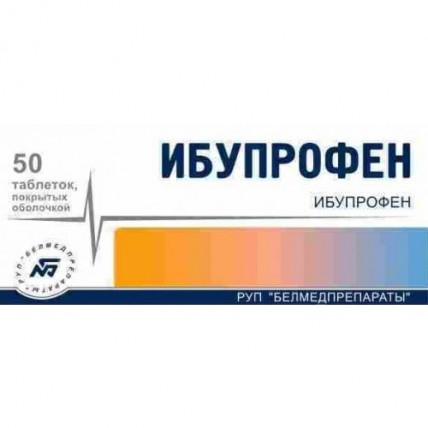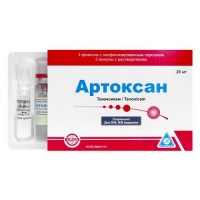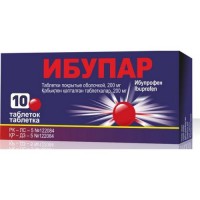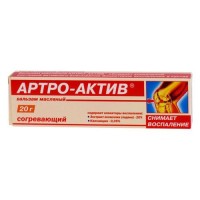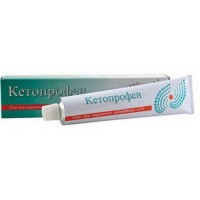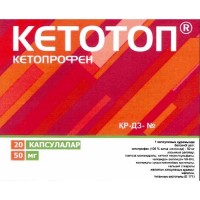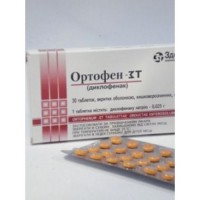Ibuprofen 200 mg coated (50 tablets)
- $2.50
Out Of Stock
Trade name
the Ibuprofen
the International unlicensed
name Ibuprofen Dosage Form
of the Tablet, film coated, 200 mg
Structure
One tablet contains
active agent an ibuprofen of 200 mg
magnesium excipients stearate, K-25 povidone, potato starch, aquarius Preferred pink
aquarius Preferred of a pink hydroksipropilmetiltsellyuloz (HPMC) 6cP, kopovidon, a polydextrose, polyethyleneglycol 3350, kaprilik/kaprik triglycerides (triglycerides of an average chain), the titan dioxide (E-171), Leyk carmoisin (E-122) (15-17%)
the Description
of the Tablet, film coated, pink color, with a biconvex surface. On a surface of tablets the roughness is allowed.
Pharmacotherapeutic group
Anti-inflammatory and antirheumatic drugs. Non-steroidal anti-inflammatory drugs. Propionic acid derivatives. The ibuprofen
the ATX M01AE01 Code
the Pharmacological
Pharmacokinetics Quickly properties is also well absorbed in the digestive tract (DT) (about 80% of the dose accepted inside). Absorption slightly decreases at administration of drug after a meal. The maximum concentration in blood plasma at reception is on an empty stomach reached in 45 min., at reception after a meal in 1.5-2.5 h, in synovial fluid in 2-3 h. Linking with proteins of blood plasma up to 90%. Slowly gets into a joint cavity, but is late in synovial fabric, creating in it high concentrations, than in plasma. Is exposed to presistemny and post-system metabolism in a liver with formation of three main metabolites. After absorption about 60% pharmacological of an inactive R-form of an ibuprofen are slowly transformed to an active S-form. CYP2C9 isoenzyme takes part in metabolism of drug. Has two-phase kinetics of elimination with elimination half-life of 2-2.5 h the Products of metabolic disintegration are brought out of an organism quickly and completely with urine. It is removed by kidneys (in not changed look no more than 1%) and to a lesser extent with bile.
The pharmacodynamics
Has analgeziruyushchy, anti-inflammatory, febrifugal effect. Inhibits cyclooxygenase I and II, blocking synthesis of prostaglandins. Analgeziruyushchy action is caused by decrease in intensity of inflammation, reduction of development and weakening of an algogennost of bradykinin, most expressed in pains of inflammatory character, anti-inflammatory by intervention in different links of pathogenesis of inflammation (the hyperpermeability of vessels is normalized, microcirculation improves, the liberation of a histamine, bradykinin and other mediators of inflammation decreases, formation of ATP is slowed down that causes decrease in power supply of inflammatory process), febrifugal action is connected with reduction of excitability of the heatregulating centers of a diencephalon. The expressiveness of antipyretic effect depends on the initial body temperature and a dose. Reversibly inhibits aggregation of thrombocytes. In a pseudorheumatism influences mainly exudative and partly on proliferative components of inflammatory reaction, has fast and expressed the anesthetizing effect, reduces puffiness, morning constraint and restriction of mobility in joints. At primary dysmenorrhea reduces the intrauterine pressure and frequency of uterine reductions. At single dose the effect proceeds up to 8 h.
Indications
- symptomatic treatment of a pain syndrome of light and average intensity: a headache, a toothache, painful periods, neuralgia, muscular, rheumatic and other types of pain
- flu and catarrhal diseases
the Route of administration and doses
Inside. Tablets should be swallowed, washing down with water, in time or after a meal.
On 1-2 tablets 3-4 times a day, if necessary on 1 tablet each 4 hours. Not to accept more often than in 4 hours. The maximum daily dose for adults should not exceed 1200 mg (no more than 6 tablets within 24 hours). Drug is intended only for short-term use inside.
Duration of use is defined by the attending physician.
Side effects
Often
- a bronchospasm, an asthma, a headache, dizziness, insomnia, excitement, irritability or fatigue,
- gastrointestinal ulcers, heartburn, an abdominal pain, nausea, vomiting, a meteorism, diarrhea, abdominal pains, gastrointestinal and other bleedings
Sometimes
- decrease in hearing, a ring or sonitus
- disorders of vision, a diplopia, dryness and irritation of eyes, a chemosis and a century (allergic genesis)
- skin rash, an itching, a small tortoiseshell and also asthma attacks (sometimes with falling of arterial blood pressure), sweating strengthening
- hypostasis, especially at patients with an arterial hypertension or a renal failure, a nephrotic syndrome, interstitial nephrite
Very seldom
- changes of a picture of blood (anemia, a Werlhof's disease, a leukopenia, thrombocytopenia, a pancytopenia, an agranulocytosis)
- drowsiness, a depression, confusion of consciousness, a hallucination
- heart failure, hypertensia, tachycardia
- abnormal liver functions
- exacerbation of nonspecific ulcer colitis and Crohn's disease
- aseptic meningitis (it is frequent at patients with autoimmune diseases)
- an esophagitis, pancreatitis, hepatitis
- an acute renal failure, papillonekroz, especially at prolonged use, in combination with increase in level of urea in blood and appearance of hypostases
- bullous skin reactions, anaphylactoid reactions, an acute anaphylaxis, fever, such as Stephens-Johnson's syndrome, and toxic epidermal necrosis (scalded skin syndrome), an alopecia, allergic rhinitis
- digestive tract erosive cankers (in some cases are complicated by perforation and bleeding), irritation, dryness of a mucous membrane of an oral cavity or mouth pain, an ulceration of a mucous membrane of gums, aphthous stomatitis, anorexia.
According to preclinical, clinical, epidemiological trials and epidemiological data, prolonged use of an ibuprofen, especially in high doses (2400 mg a day), can be connected with small increase in risk of development of trombotichesky complications (for example, a myocardial infarction or a stroke).
Contraindications
- the increased susceptibility to an ibuprofen or one of other components of medicine
- a bronchospasm, asthma, rhinitis or a small tortoiseshell after intake of acetylsalicylic acid or other NPVP in the past (aspirinovy asthma)
- the stratifying aortic aneurysm,
- portal hypertensia,
- deficiency of vitamin K,
- diseases of an optic nerve, scotoma, an amblyopia, disturbance of color sight,
- pathology of a vestibular mechanism, decrease in hearing,
- gastrointestinal bleedings
- a round ulcer or a perforation of the stomach in the anamnesis in connection with former therapy NPVP, hemorrhagic diathesis, a prothrombinopenia, hemophilia,
- cerebral and vascular or other bleedings
- a heavy course of arterial hypertension
- a heavy liver failure or an active disease of a liver
- a state after performing aortocoronary shunting
- heavy heart failure
- the confirmed hyperpotassemia
- inflammatory bowel diseases
- heavy abnormal liver functions or kidneys, at reduction in the rate of glomerular filtration less than 30 ml/min.
- heavy heart failure
- pregnancy and the period of a lactation
- children's age up to 18 years
With care:
- advanced age
- a cytopenia (leukopenia and anemia)
Medicinal interactions
Inductors of microsomal oxidation (ethanol, barbiturates, rifampicin, tricyclic antidepressants) increase products of hydroxylated active metabolites, increasing risk of development of heavy toxic injuries of a liver.
Inhibitors of microsomal oxidation reduce risk of hepatotoxic action. Drug reduces hypotensive activity of vazodilatator, natriuretic and diuretic activity of furosemide and a hydrochlorothiazide. Reduces efficiency of uricosuric drugs, strengthens action of antiagregant, fibrinolitik (increase in risk of emergence of hemorrhagic complications).
In interaction with mineralokortikosteroida, glucocorticosteroids, colchicine, estrogen, ethanol can cause ulcerogenic action with bleeding.
Enhances effect of oral hypoglycemic means and insulin.
Antacids and Colestyraminum reduce absorption of an ibuprofen. Increases concentration in blood of digoxin, Phenytoinum, a methotrexate, lithium in blood plasma.
Caffeine enhances analgeziruyushchy effect of an ibuprofen. At simultaneous use with acetylsalicylic acid reduces the cumulative anti-inflammatory effect.
At use with thrombolytic means (alteplazy, streptokinase, an urokinase) risk of developing bleedings at the same time increases.
Tsefamandol, tsefoperazon, tsefotetan, valproic acid, increase the frequency of development of a prothrombinopenia. Cyclosporine and drugs of gold strengthen influence of an ibuprofen on synthesis of prostaglandins in kidneys that is shown by increase in nephrotoxicity.
The ibuprofen increases plasma concentration of cyclosporine and a likelihood of development of its hepatotoxic effects.
The drugs blocking canalicular secretion reduce removal and increase plasma concentration of an ibuprofen.
At simultaneous use of an ibuprofen with kaliysberegayushchy diuretics the risk of development of a hyperpotassemia, with other non-steroidal anti-inflammatory drugs increases risk of development of side effects from digestive tract.
Special instructions
during treatment the intake of ethanol is not recommended.
Cherry and currant juice, sugar syrup increase the speed of absorption of an ibuprofen.
For reduction of risk of development of the undesirable phenomena from digestive tract it is necessary to use a minimal effective dose minimum possible short course.
Persons with digestive tract pathology. During use of an ibuprofen the careful medical observation of patients who have complaints from bodies of digestive tract, a digestive tract canker in the anamnesis and also nonspecific ulcer colitis or Crohn's disease is necessary. Against the background of use of an ibuprofen for this group of patients there can be (for the first time or repeatedly) gastrointestinal bleeding or ulceration/perforation of digestive tract which can not be followed by symptoms harbingers. In all such cases drug has to be cancelled.
Persons with pathology of a system of blood. The ibuprofen temporarily inhibits aggregation of thrombocytes therefore at patients with disturbances of a hemostasis the careful control of the corresponding laboratory indicators is necessary. At prolonged use of an ibuprofen the systematic control of peripheral blood is shown.
Persons with liver diseases. During use of an ibuprofen perhaps tranzitorny increase in activity of liver enzymes. At long therapy the ibuprofen as a precautionary measure showed laboratory control of function of a liver. If disturbances from functional indicators remain or amplify and also if there are clinical manifestations of other damages of a liver, the ibuprofen should be cancelled. It is necessary to remember that hepatitis against the background of use of an ibuprofen can arise without prodromal manifestations.
Persons with pathology of a cardiovascular system. As prostaglandins play an important role in maintenance of a normal renal blood-groove, the extra care is required when using an ibuprofen from the patients having renal failures and chronic stagnant heart failure at the persons receiving diuretic means and also at patients with considerable reduction of volume of the circulating plasma (for example, during the period before massive surgical interventions). In all these cases the control of function of kidneys is recommended as a precautionary measure. Drug phase-out usually leads to restoration of function of kidneys to initial level.
Influence on laboratory indicators. In need of definition of 17 ketosteroids in urine, reception of an ibuprofen has to be stopped for 48 h before carrying out the analysis.
Pregnancy and the period of a lactation
Use of an ibuprofen during pregnancy is possible only when the expected advantage for mother exceeds potential risk for a fruit. It is necessary to appoint drug in a minimal effective dose. Use of an ibuprofen in the III trimester of pregnancy in connection with possible oppression of sokratitelny ability of a uterus and premature closing of an arterial channel at a fruit is not recommended.
Suppression of synthesis of prostaglandins can have an adverse effect on pregnancy and pre-natal fetation. Data of epidemiological researches show the increased risk of an abortion and malformations of heart and digestive tract after use of inhibitors of synthesis of prostaglandins in early pregnancy. At animals it is shown that administration of inhibitors of synthesis of prostaglandins leads to increase to - and the postimpla-tatsionny lethality of an embryo and a fruit. Besides, at the animals receiving inhibitors of synthesis of prostaglandins in the period of an organogenesis the frequency of various malformations, including a cardiovascular system increases.
During the first and second trimester of pregnancy it is necessary to avoid purpose of an ibuprofen, except for cases of unconditional need. During the third trimester of pregnancy, use of any inhibitors of synthesis of prostaglandins can result in cardiopulmonary toxicity (with premature closing of an arterial channel and pulmonary hypertensia), to a renal failure which can progress to a renal failure with an oligoamnios.
At the end of pregnancy, inhibitors of synthesis of prostaglandins can subject mother and the newborn to risk owing to a possibility of lengthening of a bleeding time, oppression of reductions of a uterus that can lead to a delay or long childbirth.
Therefore, the ibuprofen is contraindicated during the third trimester of pregnancy.
The ibuprofen gets into breast milk therefore at its use in the period of a lactation it is necessary to provide the termination of breastfeeding for the entire period of treatment.
The feature of influence of medicine on ability to run vehicles or other potentially dangerous mechanisms
during use of an ibuprofen needs to abstain from all types of activity requiring special attention, fast mental and motor reaction.
Overdose
Symptoms: abdominal pain, nausea, vomiting, block, drowsiness, depression, headache, sonitus, metabolic acidosis, coma, acute renal failure, lowering of arterial pressure, bradycardia, tachycardia, fibrillation of auricles, apnoea.
Treatment: symptomatic therapy, gastric lavage (only within an hour after reception), use of activated carbon. Specific antidote does not exist.
Form of release and packing
of the Tablet, coated, 200 mg.
On 10 tablets in blister strip packaging from a film of polyvinylchloride and aluminum foil.
5 blister strip packagings together with the instruction for use in the state and Russian languages place in a pack from cardboard.
To Store storage conditions in the place protected from moisture and light at a temperature not higher than 25 C.
To store out of children's reach!
3 years
not to apply a period of storage after expiry date.
Prescription status
According to the prescription
RUP Producer of Belmedpreparata, Republic of Belarus
to Develop
the Ibuprofen
the International unlicensed
name Ibuprofen Dosage Form
of the Tablet, film coated, 200 mg
Structure
One tablet contains
active agent an ibuprofen of 200 mg
magnesium excipients stearate, K-25 povidone, potato starch, aquarius Preferred pink
aquarius Preferred of a pink hydroksipropilmetiltsellyuloz (HPMC) 6cP, kopovidon, a polydextrose, polyethyleneglycol 3350, kaprilik/kaprik triglycerides (triglycerides of an average chain), the titan dioxide (E-171), Leyk carmoisin (E-122) (15-17%)
the Description
of the Tablet, film coated, pink color, with a biconvex surface. On a surface of tablets the roughness is allowed.
Pharmacotherapeutic group
Anti-inflammatory and antirheumatic drugs. Non-steroidal anti-inflammatory drugs. Propionic acid derivatives. The ibuprofen
the ATX M01AE01 Code
the Pharmacological
Pharmacokinetics Quickly properties is also well absorbed in the digestive tract (DT) (about 80% of the dose accepted inside). Absorption slightly decreases at administration of drug after a meal. The maximum concentration in blood plasma at reception is on an empty stomach reached in 45 min., at reception after a meal in 1.5-2.5 h, in synovial fluid in 2-3 h. Linking with proteins of blood plasma up to 90%. Slowly gets into a joint cavity, but is late in synovial fabric, creating in it high concentrations, than in plasma. Is exposed to presistemny and post-system metabolism in a liver with formation of three main metabolites. After absorption about 60% pharmacological of an inactive R-form of an ibuprofen are slowly transformed to an active S-form. CYP2C9 isoenzyme takes part in metabolism of drug. Has two-phase kinetics of elimination with elimination half-life of 2-2.5 h the Products of metabolic disintegration are brought out of an organism quickly and completely with urine. It is removed by kidneys (in not changed look no more than 1%) and to a lesser extent with bile.
The pharmacodynamics
Has analgeziruyushchy, anti-inflammatory, febrifugal effect. Inhibits cyclooxygenase I and II, blocking synthesis of prostaglandins. Analgeziruyushchy action is caused by decrease in intensity of inflammation, reduction of development and weakening of an algogennost of bradykinin, most expressed in pains of inflammatory character, anti-inflammatory by intervention in different links of pathogenesis of inflammation (the hyperpermeability of vessels is normalized, microcirculation improves, the liberation of a histamine, bradykinin and other mediators of inflammation decreases, formation of ATP is slowed down that causes decrease in power supply of inflammatory process), febrifugal action is connected with reduction of excitability of the heatregulating centers of a diencephalon. The expressiveness of antipyretic effect depends on the initial body temperature and a dose. Reversibly inhibits aggregation of thrombocytes. In a pseudorheumatism influences mainly exudative and partly on proliferative components of inflammatory reaction, has fast and expressed the anesthetizing effect, reduces puffiness, morning constraint and restriction of mobility in joints. At primary dysmenorrhea reduces the intrauterine pressure and frequency of uterine reductions. At single dose the effect proceeds up to 8 h.
Indications
- symptomatic treatment of a pain syndrome of light and average intensity: a headache, a toothache, painful periods, neuralgia, muscular, rheumatic and other types of pain
- flu and catarrhal diseases
the Route of administration and doses
Inside. Tablets should be swallowed, washing down with water, in time or after a meal.
On 1-2 tablets 3-4 times a day, if necessary on 1 tablet each 4 hours. Not to accept more often than in 4 hours. The maximum daily dose for adults should not exceed 1200 mg (no more than 6 tablets within 24 hours). Drug is intended only for short-term use inside.
Duration of use is defined by the attending physician.
Side effects
Often
- a bronchospasm, an asthma, a headache, dizziness, insomnia, excitement, irritability or fatigue,
- gastrointestinal ulcers, heartburn, an abdominal pain, nausea, vomiting, a meteorism, diarrhea, abdominal pains, gastrointestinal and other bleedings
Sometimes
- decrease in hearing, a ring or sonitus
- disorders of vision, a diplopia, dryness and irritation of eyes, a chemosis and a century (allergic genesis)
- skin rash, an itching, a small tortoiseshell and also asthma attacks (sometimes with falling of arterial blood pressure), sweating strengthening
- hypostasis, especially at patients with an arterial hypertension or a renal failure, a nephrotic syndrome, interstitial nephrite
Very seldom
- changes of a picture of blood (anemia, a Werlhof's disease, a leukopenia, thrombocytopenia, a pancytopenia, an agranulocytosis)
- drowsiness, a depression, confusion of consciousness, a hallucination
- heart failure, hypertensia, tachycardia
- abnormal liver functions
- exacerbation of nonspecific ulcer colitis and Crohn's disease
- aseptic meningitis (it is frequent at patients with autoimmune diseases)
- an esophagitis, pancreatitis, hepatitis
- an acute renal failure, papillonekroz, especially at prolonged use, in combination with increase in level of urea in blood and appearance of hypostases
- bullous skin reactions, anaphylactoid reactions, an acute anaphylaxis, fever, such as Stephens-Johnson's syndrome, and toxic epidermal necrosis (scalded skin syndrome), an alopecia, allergic rhinitis
- digestive tract erosive cankers (in some cases are complicated by perforation and bleeding), irritation, dryness of a mucous membrane of an oral cavity or mouth pain, an ulceration of a mucous membrane of gums, aphthous stomatitis, anorexia.
According to preclinical, clinical, epidemiological trials and epidemiological data, prolonged use of an ibuprofen, especially in high doses (2400 mg a day), can be connected with small increase in risk of development of trombotichesky complications (for example, a myocardial infarction or a stroke).
Contraindications
- the increased susceptibility to an ibuprofen or one of other components of medicine
- a bronchospasm, asthma, rhinitis or a small tortoiseshell after intake of acetylsalicylic acid or other NPVP in the past (aspirinovy asthma)
- the stratifying aortic aneurysm,
- portal hypertensia,
- deficiency of vitamin K,
- diseases of an optic nerve, scotoma, an amblyopia, disturbance of color sight,
- pathology of a vestibular mechanism, decrease in hearing,
- gastrointestinal bleedings
- a round ulcer or a perforation of the stomach in the anamnesis in connection with former therapy NPVP, hemorrhagic diathesis, a prothrombinopenia, hemophilia,
- cerebral and vascular or other bleedings
- a heavy course of arterial hypertension
- a heavy liver failure or an active disease of a liver
- a state after performing aortocoronary shunting
- heavy heart failure
- the confirmed hyperpotassemia
- inflammatory bowel diseases
- heavy abnormal liver functions or kidneys, at reduction in the rate of glomerular filtration less than 30 ml/min.
- heavy heart failure
- pregnancy and the period of a lactation
- children's age up to 18 years
With care:
- advanced age
- a cytopenia (leukopenia and anemia)
Medicinal interactions
Inductors of microsomal oxidation (ethanol, barbiturates, rifampicin, tricyclic antidepressants) increase products of hydroxylated active metabolites, increasing risk of development of heavy toxic injuries of a liver.
Inhibitors of microsomal oxidation reduce risk of hepatotoxic action. Drug reduces hypotensive activity of vazodilatator, natriuretic and diuretic activity of furosemide and a hydrochlorothiazide. Reduces efficiency of uricosuric drugs, strengthens action of antiagregant, fibrinolitik (increase in risk of emergence of hemorrhagic complications).
In interaction with mineralokortikosteroida, glucocorticosteroids, colchicine, estrogen, ethanol can cause ulcerogenic action with bleeding.
Enhances effect of oral hypoglycemic means and insulin.
Antacids and Colestyraminum reduce absorption of an ibuprofen. Increases concentration in blood of digoxin, Phenytoinum, a methotrexate, lithium in blood plasma.
Caffeine enhances analgeziruyushchy effect of an ibuprofen. At simultaneous use with acetylsalicylic acid reduces the cumulative anti-inflammatory effect.
At use with thrombolytic means (alteplazy, streptokinase, an urokinase) risk of developing bleedings at the same time increases.
Tsefamandol, tsefoperazon, tsefotetan, valproic acid, increase the frequency of development of a prothrombinopenia. Cyclosporine and drugs of gold strengthen influence of an ibuprofen on synthesis of prostaglandins in kidneys that is shown by increase in nephrotoxicity.
The ibuprofen increases plasma concentration of cyclosporine and a likelihood of development of its hepatotoxic effects.
The drugs blocking canalicular secretion reduce removal and increase plasma concentration of an ibuprofen.
At simultaneous use of an ibuprofen with kaliysberegayushchy diuretics the risk of development of a hyperpotassemia, with other non-steroidal anti-inflammatory drugs increases risk of development of side effects from digestive tract.
Special instructions
during treatment the intake of ethanol is not recommended.
Cherry and currant juice, sugar syrup increase the speed of absorption of an ibuprofen.
For reduction of risk of development of the undesirable phenomena from digestive tract it is necessary to use a minimal effective dose minimum possible short course.
Persons with digestive tract pathology. During use of an ibuprofen the careful medical observation of patients who have complaints from bodies of digestive tract, a digestive tract canker in the anamnesis and also nonspecific ulcer colitis or Crohn's disease is necessary. Against the background of use of an ibuprofen for this group of patients there can be (for the first time or repeatedly) gastrointestinal bleeding or ulceration/perforation of digestive tract which can not be followed by symptoms harbingers. In all such cases drug has to be cancelled.
Persons with pathology of a system of blood. The ibuprofen temporarily inhibits aggregation of thrombocytes therefore at patients with disturbances of a hemostasis the careful control of the corresponding laboratory indicators is necessary. At prolonged use of an ibuprofen the systematic control of peripheral blood is shown.
Persons with liver diseases. During use of an ibuprofen perhaps tranzitorny increase in activity of liver enzymes. At long therapy the ibuprofen as a precautionary measure showed laboratory control of function of a liver. If disturbances from functional indicators remain or amplify and also if there are clinical manifestations of other damages of a liver, the ibuprofen should be cancelled. It is necessary to remember that hepatitis against the background of use of an ibuprofen can arise without prodromal manifestations.
Persons with pathology of a cardiovascular system. As prostaglandins play an important role in maintenance of a normal renal blood-groove, the extra care is required when using an ibuprofen from the patients having renal failures and chronic stagnant heart failure at the persons receiving diuretic means and also at patients with considerable reduction of volume of the circulating plasma (for example, during the period before massive surgical interventions). In all these cases the control of function of kidneys is recommended as a precautionary measure. Drug phase-out usually leads to restoration of function of kidneys to initial level.
Influence on laboratory indicators. In need of definition of 17 ketosteroids in urine, reception of an ibuprofen has to be stopped for 48 h before carrying out the analysis.
Pregnancy and the period of a lactation
Use of an ibuprofen during pregnancy is possible only when the expected advantage for mother exceeds potential risk for a fruit. It is necessary to appoint drug in a minimal effective dose. Use of an ibuprofen in the III trimester of pregnancy in connection with possible oppression of sokratitelny ability of a uterus and premature closing of an arterial channel at a fruit is not recommended.
Suppression of synthesis of prostaglandins can have an adverse effect on pregnancy and pre-natal fetation. Data of epidemiological researches show the increased risk of an abortion and malformations of heart and digestive tract after use of inhibitors of synthesis of prostaglandins in early pregnancy. At animals it is shown that administration of inhibitors of synthesis of prostaglandins leads to increase to - and the postimpla-tatsionny lethality of an embryo and a fruit. Besides, at the animals receiving inhibitors of synthesis of prostaglandins in the period of an organogenesis the frequency of various malformations, including a cardiovascular system increases.
During the first and second trimester of pregnancy it is necessary to avoid purpose of an ibuprofen, except for cases of unconditional need. During the third trimester of pregnancy, use of any inhibitors of synthesis of prostaglandins can result in cardiopulmonary toxicity (with premature closing of an arterial channel and pulmonary hypertensia), to a renal failure which can progress to a renal failure with an oligoamnios.
At the end of pregnancy, inhibitors of synthesis of prostaglandins can subject mother and the newborn to risk owing to a possibility of lengthening of a bleeding time, oppression of reductions of a uterus that can lead to a delay or long childbirth.
Therefore, the ibuprofen is contraindicated during the third trimester of pregnancy.
The ibuprofen gets into breast milk therefore at its use in the period of a lactation it is necessary to provide the termination of breastfeeding for the entire period of treatment.
The feature of influence of medicine on ability to run vehicles or other potentially dangerous mechanisms
during use of an ibuprofen needs to abstain from all types of activity requiring special attention, fast mental and motor reaction.
Overdose
Symptoms: abdominal pain, nausea, vomiting, block, drowsiness, depression, headache, sonitus, metabolic acidosis, coma, acute renal failure, lowering of arterial pressure, bradycardia, tachycardia, fibrillation of auricles, apnoea.
Treatment: symptomatic therapy, gastric lavage (only within an hour after reception), use of activated carbon. Specific antidote does not exist.
Form of release and packing
of the Tablet, coated, 200 mg.
On 10 tablets in blister strip packaging from a film of polyvinylchloride and aluminum foil.
5 blister strip packagings together with the instruction for use in the state and Russian languages place in a pack from cardboard.
To Store storage conditions in the place protected from moisture and light at a temperature not higher than 25 C.
To store out of children's reach!
3 years
not to apply a period of storage after expiry date.
Prescription status
According to the prescription
RUP Producer of Belmedpreparata, Republic of Belarus
to Develop
